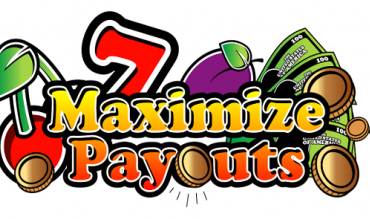The first question on any slot machine player’s mind is, “How do I win?” The question evolves with experienced players who think about it a little. They wonder, “Maybe I can’t always win, but how to I maximize my paybacks?
Slot machines are games of chance, With rare exceptions, there is no skill involved, and there is no method of play that will make them pay more than they’re designed to pay.
With that in mind, maximizing slot payouts comes down to choice of games and making the wagers necessary to get the most they have to offer.
HIGH DENOMINATION VS. LOW DENOMINATION
In the United States, where many state gaming boards publish statistics each month, nationwide averages look like this:
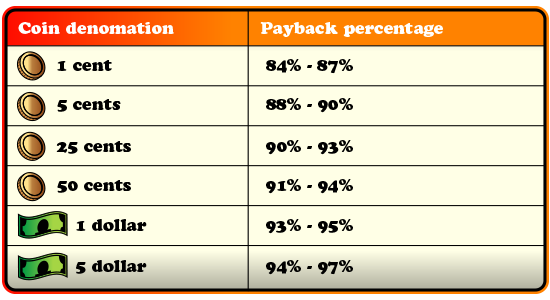
Those are national averages, but can vary widely from state to state and casino to casino, depending on the competitive situation and marketing goals of the casinos. For a real-world example, let’s look at the state of Mississippi and October 2015 payback percentages published by the Mississippi Gaming Commission:
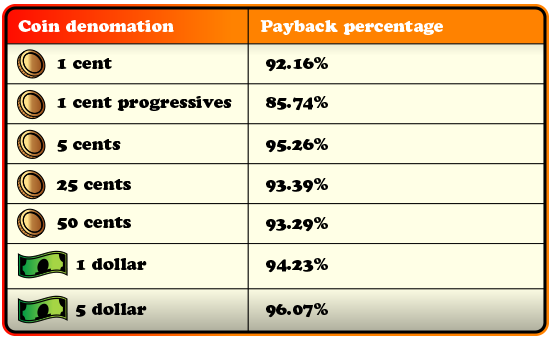
On video slots, Mississippi casinos pay far above the national average on both penny non-progressives and on five-cent games. But the normal pattern holds in that the higher denomination slots pay a greater percentage back to players than the lower denomination games.
The 25-cent-and-up slots are mostly games with mechanical reels. Although in Mississippi the 25-cent and 50-cent games provide nearly equal returns, and the difference is narrower than usual between 25-cent and $1 games, you still can see a pattern where $5 games pay more than $1 games, which pay more than 25-cent games.
BOTTOM LINE
- Playing higher-denomination slots usually will put you at higher-paying machines.
- Caution: If you bet one coin per line on a 20-line video slot, you’re betting 20 cents on a penny slot, but $1 on five-cent slots.
- That difference in wager size means you can lose more money even while getting a higher payback percentage. If the 1-cent slot returns 87 percent and the 5-cent game returns 90 percent, then your loss per 20-coin wager is 2.6 cents on the 1-cent game, and 10 cents on the 5-cent game.
- Conclusion: Let your bankroll be your guide. If higher-denomination games fit within your entertainment budget, they can maximize payback and give you a better shot to win. But if they’d stretch your budget, it’s better to stay low. Never bet money you can’t afford to lose.
BETTING THE MAX
On many slot machines, including nearly all games with three mechanical reels, you get a higher payback percentage if you bet the maximum number of coins the game allows.
Here’s a sample pay table:
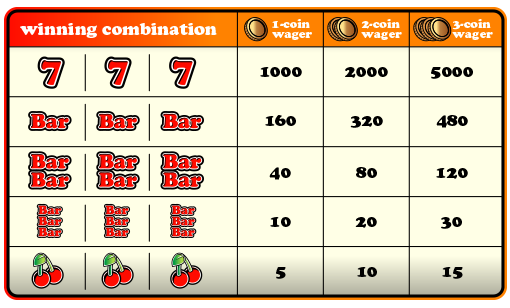
Note the disproportionate jump in the top jackpot. If the payoffs were perfectly proportional, the payback percentage would be same regardless of how many coins you wagered.
But betting the third coin brings a rise in payback percentage. Look at it this way:
- Each coin wagered brings the same return on cherries, bars, double bars and triple bars. A 15-coin payoff on three cherries breaks down into a 5-coin return for the first coin wagered, 5 for the second and 5 for the third.
- Payoffs on 7s are proportional through two coins. A 2,000-coin payoff breaks down into 1,000 on the first coin and 1,000 on the second.
- However, if you land the 7s on the payline with the maximum three-coin bet, the 5,000-coin return breaks down into 1,000 on the first coin, 1,000 on the second and a big leap to 3,000 on the third.
- The average payback on three 7s is 1,000 per coin wagered if you bet one or two coins, but 1,667 per coins wagered if you bet the maximum three.
- That higher average payback with three coins wagered means the payback percentage is higher when you bet the max.
- Caution: You maximize return when you bet the max, but you also have more money at risk and can have larger losses. Don’t overbet your bankroll.
The situation is different on five-reel video slots. Paybacks are proportional to coins wagered per payline on these games, with no jackpot jump for betting the max.
Here’s a sample pay table for a 20-payline, five-reel video game:
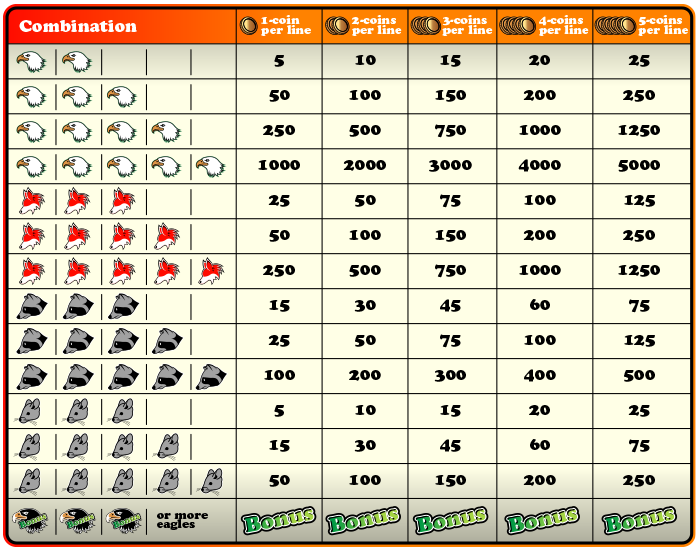
There are a few notable things about that pay table:
- It is simplified from the pay tables you actually see in casinos, which use more character symbols and also often use generic symbols such as A-K-Q-J-10. Many video slots also include more than one bonus event.
- Despite the simplification, there are many more possible winning combinations than on the three-reel slot. Even two in a row of the top-paying symbol brings some payoff.
- As set up, this game with 20 paylines and a five-coin maximum bet per line would have a maximum total bet of 100 coins. Games you’ll find in casinos often have much higher maximum bets, such as 20 coins per line on a 20-line game, or 10 coins per line on a 40-line game, for a total of 400 coins.
- The pay table is proportional from to bottom, so there is no advantage to betting maximum coins. You’ll get the same payback percentage regardless of whether you bet one coin per line or five.
BE ELIGIBLE TO WIN
On the video slot game illustrated above, there is no pay table incentive to wager maximum coins per line. However, it might be to your advantage to make sure you bet on every payline.
Why? Because on some machines, the bonus symbols must land on an active payline for you to be eligible for the free spins, wheel spin, pick-a-symbol round or whatever other special event has been designed into the game.
An example:
- You decide to bet a single coin. That activates only the center payline.
- You go to the bonus event if three bonus symbols land on the center line. On most video slots, they don’t have to be on consecutive reels, from left to right, as most paying symbols do. You’ll go to the bonus even if the symbols are in the center of reels 2, 3 and 5, or 1, 2 and 4, or any other combination.
- However, if the reels land on any line you have not activated, you do not go to the bonus.
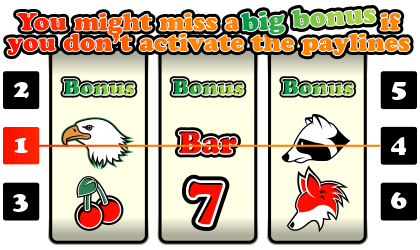
- Time spent in bonus events is time you spend building credits without making extra wagers, so you want to maximize your chances of going to the bonuses.
- Bottom line: To maximize payouts, make sure you’re eligible for the bonuses offered.
- Note: Some newer games avoid the issue by eliminating the option to play fewer paylines than available. A 40-line game might have buttons labeled “Bet 40,” “Bet 80,” “Bet 120,” “Bet 160,” and “Bet 200,” giving you options to bet one, two, three, four or five credits per line, but no chance to play only one line. In the slot industry, these are called “forced bet” machines.
Reading the glass or help menu can save you in some other situations, too.
Consider this three-reel slot pay table:
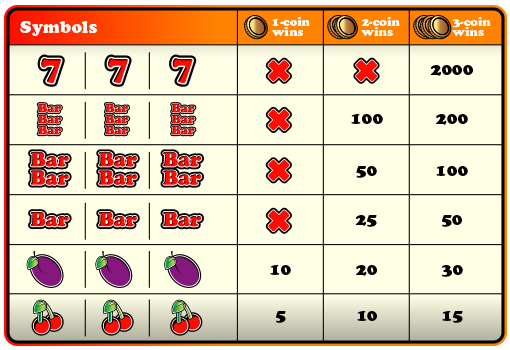
This type of machine is called a buy-a-pay. Each coin you wager unlocks a set of symbols, if you wager only one coin and line up three 7s, you don’t hit the jackpot, you get nothing. It’s just a losing spin.
On such a machine, you maximize payouts by betting the max to such an extent that you should never play if you’re not prepared to make the maximum wager.
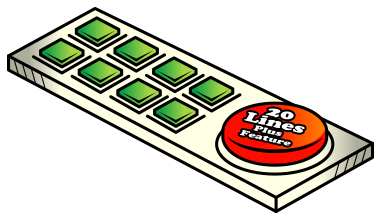
One more example of where reading the glass or help menu can save you some grief:
On many video slot machines with progressive jackpots, especially those with two, three, four or more levels of progressive, you must make a separate wager to be eligible for the jackpots.
Sometimes the button panel includes a separate button that includes covering all the paylines plus jackpot eligibility. Often it’s large and round and oval, to stand out from the small, square buttons for the usual choices of how many paylines to play and how many coins to wager per line.
The amount required for jackpot eligibility varies in different machines. It’s not unusual to see 10, 15 or 20-credit bets for the jackpot. On a game with a 10-credit jackpot bet, if you cover 20 paylines at 1 credit per line and make the jackpot bet, your total wager is 30 credits.
If you bet five credits per line, you’re betting 100 credits in the main game and 10 on the jackpot for a total wager of 110 credits.
The progressive jackpots are the prime attraction of such games. You maximize your return by making the jackpot bet. If you do not want to make the jackpot bet, you’re better off to choose a different game.
SCOUTING PROGRESSIVES
Some players like to attempt to maximize their returns by scouting machines with progressive jackpots.
To do their scouting, they’ll visit casinos and note the starting points for progressive jackpots, and try to find out when they hit. Such charting requires frequent visits, and often requires asking slot attendants, “I see that jackpot just hit recently. How much was it?”
They build a data base that might look like this:
- Jackpot starting point: $5,000.
- Jackpot winners: $8,663; $5,981; $7,453; $9,012; $8,114; $7,888; $10, 576; $8,243.
- More data collected over longer time is better.
- From that, they determine that while jackpots sometimes hit at a little more than the starting point and sometimes exceed $10,000, they most often hit between about $7,400 and $8,700.
- Based on that information, they don’t play unless the jackpot exceeds $7,400.
- Actual jackpot amounts and average payout will differ from game to game and casino to casino.
Because such players do not bet when the jackpots are low, they always are playing at relatively high pay tables. That maximizes their payback percentage.
However, betting when the jackpot is high doesn’t increase your chances of hitting the jackpot, it just makes the average payout higher when you do win. Just as in any other method of maximizing payouts, rule Nos. 1, 2 and 3 are to stay within your bankroll, not bet money you can’t afford to lose, and to choose games that fit your budget.
